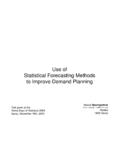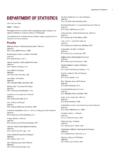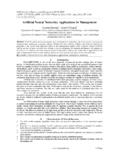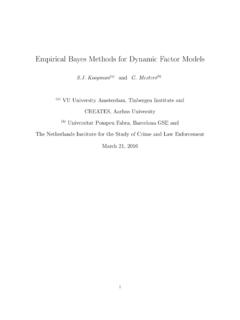Transcription of Overview of cost definitions and methodologies by …
1 Overview of cost definitions and costing methods by James Ruth 1. cost definitions cost : The total money, time, and resources associated with a purchase or activity. Fixed cost : Includes all costs that do not vary with activity for an accounting period. Fixed costs are, at any time, the inevitable costs that must be paid regardless of the level of output and of the resources used. A Fixed cost is therefore not an Opportunity cost . Overhead is considered a fixed cost , even though it may vary somewhat according to the amount of activity. Any cost that does not vary depending on production, volume, use, or sales levels, such as rent, property tax, insurance, or interest expense. Related Terms: variable cost , total cost , fixed expenses Variable cost : All other costs that are some function of activity. They are usually considered linear because the unit cost is computed by dividing the total other costs for a period, or event, by the amount of activity in the period.
2 The linear assumption is a matter of convenience. As the level of activity is varied, the non linear nature of the variable costs are revealed. A cost of labor, material or overhead that changes according to the change in the volume used. Combined with fixed costs, variable costs make up the total cost . While the total variable cost changes with increased usage, the total fixed cost stays the same. Related Terms: fixed cost , break-even analysis Total costs are usually expressed as Fixed + Variable Total cost definition 1: In accounting, the sum of fixed costs, variable costs, and semi-variable costs. definition 2: In the context of investments, the total amount spent on a particular investment, including the price of the investment itself, plus commissions, fees, other transaction costs, and taxes. Related Terms: average price per share, original cost Mixed cost : A cost with both fixed and variable elements. Direct cost : Costs that can be identified directly with a particular process, project, or program.
3 Indirect cost : Costs associated with an enterprise, activity, etc. which are not identified as direct costs, but which may be included in the accounting. Incremental Costs (& Revenue): Those costs (or revenues) that change due to an incremental change in activity, as compared those that are unaffected. Marginal cost : The cost associated with one additional unit of production or use, also called incremental cost . Opportunity cost : The benefit foregone by choosing one course of action over another, or the net revenue that is forgone by not allocating resources to another alternative use. The opportunity cost is the correct measure of the cost of resources for Systems Analysis. Whereas it can be equal to the price paid for a resource, it is often different from the outlay cost . Resources may cost something to use (or not use) even though no monetary price is paid to another entity for them. The opportunity cost is the Shadow Price of a resource.
4 In effect opportunity costs, in representing the cost of having less of a resource, measure the rate of change of benefits per unit change in resource. The opportunity cost of money is a measure of the maximum benefit that, for any given situation, can be obtained from any extra unit of capital. A useful distinction can be made between resources that can be identically replaced (such a materials, money, etc.) and those that are somehow unique ( a piece of property). For strictly replaceable resources for which there is a ready market, the opportunity cost is simply the market cost of replacement, or equivalently, the salvage price of the resource if it is already at hand and will not be replaced. Measuring opportunity cost is not particularly easy. For example, if an asset such as capital is used for one purpose, the opportunity cost is the value of the next best purpose the asset could have been used for. Opportunity cost analysis can be an important part of a decision-making processes, but is not treated as an actual cost in any financial statement.
5 Related Terms: cost of capital, cutoff point, idle, comparative advantage, economic value added Sunk Costs: - theoretically those prior costs which cannot be recovered. For normal private sector accounting purposes, the sunk cost is the difference between book value and salvage value of an asset. This definition is disputed by some accountants as there is a historical cost element (any prior spending), and a future (negative cost or) revenue element, if salvage is eventually undertaken. For the public sector it is usually any money spent previously on a program or project that can never be recovered, , costs already incurred which cannot be recovered regardless of future events. Sunk costs should be ignored in determining whether a new investment is worthwhile. Life Cycle Costs are the total cost to an organization for acquisition and ownership of a product or asset over the life of the asset. For example, the life cycle cost of a school includes all of the future maintenance and repairs, as well as the initial construction and fixtures cost .
6 This is sometimes referred to as capital costs plus operating costs, or one- time costs plus recurring costs. Any program should calculate life cycle costs. cost -Effectiveness Analysis. A program is cost -effective if, on the basis of life cycle cost analysis of competing alternatives, it is determined to have the lowest costs expressed in present value terms for a given amount of benefits. cost -effectiveness analysis can also be used to compare programs with identical costs but differing benefits. In this case, the decision criterion is the discounted present value of benefits. The alternative program with the largest benefits would normally be favored. OMB Circular No. A-94. Depreciated cost : The original cost of an asset minus total its depreciation thus far, also called net book value or written-down value. Standard Costing: A management tool used to estimate the overall cost of production, assuming normal operations.
7 Transaction Costs: Costs incurred when buying or selling assets, such as commissions and the spread. Unit cost : cost per item. 2. Costing Methods Costing is important because it provides a quantified basis for defining poverty reduction strategies and programs, as well as for forecasting resource gaps and needs, and for mobilizing additional resources, either internally or externally. While it is usually not possible to obtain reliable cost estimates for the long-term, costing is essential for coordinating the national budget and aid allocations with the prioritized development goals. The price tag and the financing plan of the programs or projects can only be ascertained meaningfully within a short-to-medium time horizon. There are several common costing methodologies , and they all have their usefulness in specific situations. However, no one single methodology is appropriate for every situation. All cost estimates must be interpreted with caution and scrutinized carefully.
8 Nobody should be utterly confident of their precision. In short, there is no universally robust or best way of costing programs or projects. Since it is better to be broadly right than to be precisely wrong, cost estimates are sometimes best seen as orders of magnitude, expressed as a range rather than a single figure. Some of the common generic approaches to costing are: adapted and edited from [ ]. Top-Down, Algorithmic, or Parametric (often used when fine detail is not available). Bottom-Up, or Industrial Engineering (usually used when fine detail is available). Expert Judgment (experts estimate or guesstimate' project costs). Work Forward, Work Back (when the project has a specific due date). Activity Based Costing (time consuming and requires accurate data). Analogy (comparing similar and like for like projects). Quick and Dirty Costing (fast, but accurate to an order of magnitude only). Three specific alternative approaches to costing Poverty Reduction Strategy (PRS) goals are: Average Costs: The cost of achieving a subset of goals using estimated average costs of service and estimated population lacking access to priority services.
9 Data sources include: activity based budgeting and census/DHS/LSMS data for unserved populations. Multivariate Analysis/Determinants Analysis: Determinants of key poverty outcomes ( infant mortality) are used for sensitivity analysis with respect to different policies. Alternative policies can be translated into unit costs, with total costs calculated for attaining certain goals. cost Effectiveness: Ranking of existing projects and programs according to the relevance of their objectives to the PRS. Priority services and target groups are identified. Information obtained from sectors and donors about the most cost effective designs for priority social services, including the costing of main and complementary inputs required. Brief Example of cost Estimating Methods Engineering economy studies and problems often concern future outcomes, estimating future cash flows during analysis is a critical step. More accurate estimates contribute to better decision making.
10 cost estimation should take place in an integrated, problem solving framework. Once the problem has been recognized and feasible alternatives have been found, the cash flows for each alternative must be researched and estimated. This can be an iterative process. An integrated approach to develop the net cash flows for feasible project alternatives is shown below. The integrated approach includes three basic components: 1. Work Breakdown Structure (WBS). This is a technique for explicitly defining, at successive levels of detail, the work elements of a project and their inter relationships (sometimes called a work element structure). 2. cost and revenue structure (classification). Delineation of the cost and revenue categories and elements is made for estimates of cash flows at each level of the WBS. 3. Estimating techniques (models). Selected mathematically models are used to estimate the future costs and revenues during the analysis period.
















